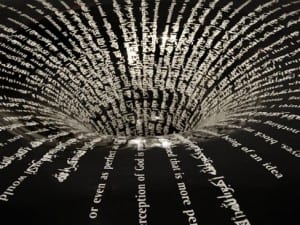Review by Carla MacKinnon
New York based artist Dustin Yellin creates his unique work by layering 2D images between sheets of glass to create extraordinary 3D images, collages and illusions. In the first room of his current show at 20 Hoxton Square, visitors are greeted by a selection of small works mounted on plinths. Yellin’s technique makes each piece a satisfying physical object; smooth square transparent bricks capture an array of cut out images ranging from the political to the comical. The images in this first space are light-hearted, almost kitsch, referencing iconic images from popular culture and the media and weaving these into unlikely tableaux. The method is reminiscent of applique, pop-up books and Victorian theatre sets, giving the work a reference point in narrative and craft.
Moving into the second room, the mood changes dramatically. The lights are lower here, and each piece is separately illuminated. The resin blocks capture this light, creating an eerie and attractive glow and imparting a sense of hushed enchantment. The subject matter seems weightier too. Landscapes and seascapes, simple from a distance, break down into complex collages of evocative visual information as a viewer moves towards them. Power Lines is a nightmarish, apocalyptic vision, combining military and industrial imagery with glimpses of an incongruous utopia in a disquiet and unnatural landscape. By contrast, The Anchorite presents a vast, empty vista across a wild, snowy valley. The piece excites a sense of awe, reenforced by the simplicity of its composition and the absence of chaotic detail present in the rest of Yellin’s work. The sense of looking through a window to a remote, frozen and inhuman corner of the world is palpable and powerful.
Till Human Voices Wake Us is a large landscape dominating the far end of the gallery. Reminiscent of a Turner seascape it initially presents a simple and traditional composition. With proximity, however, this illusion breaks and the piece reveals its secrets nestling amongst the waves. Typewriters, talismans and totems – cross-cultural material evidence of human endeavour – are tossed in the stormy sea. The items range from the iconic to the seemingly random. Some are fully visible while others nestle between waves, only partially visible. There is a sense that we can only see a fraction of the material trapped between the many resin waves. The sea itself is masterfully constructed. Yellin impressively captures a wild energy through his extraordinarily exact and disciplined technique.
In the centre of the gallery space is Osiris on The Table. In the myth of Osiris, the God-Pharaoh is killed but reconstructed by his mourning wife, who brings him back to life through her love. Yellin’s portrayal of Osiris sees him constructed out of thousands of tiny elements. Insects, plants, waves and flames combine with inorganic materials to create a sculptural recreation of a human form. The work could be viewed as some meeting point between Fred Tomaselli’s fantastical creations, Hirst’s dissected animals and Arcimboldo’s 16th Century portraits of heads made from animals, plants or food. Here the body becomes a landscape, an environment of controlled chaos hinting at both decomposition and complex living ecosystems. The anatomy seems whimsical and symbolic by turns, each layer and each body part telling a story. As in the myth, the love and care invested in this piece breathes life into it. The work is an astonishing, unforgettable effigy, simultaneously a single organism and a self-contained universe.
Dustin Yellin Osiris on the Table continues until March 12. For more information on 20 Hoxton Square please visit www.20hoxtonsquare.com
Image: Courtesy of 20 Hoxton Square and Dustin Yellin.





